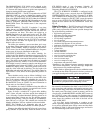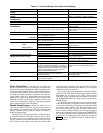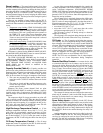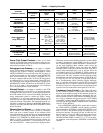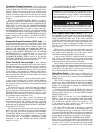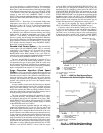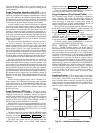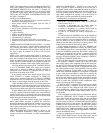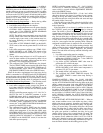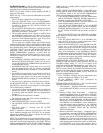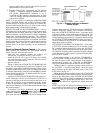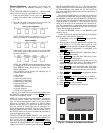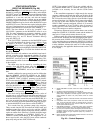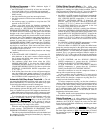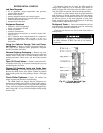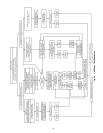
42
Standby Chiller Configuration and Operation
— A chiller is
designated as a standby chiller when its LEADLAG: CONFIG-
URATION value on the LEADLAG screen is set to “3.” The
standby chiller can operate as a replacement for the lag chiller
only if one of the other two chillers is in an alarm (*) condition
(as shown on the CVC/ICVC panel). If both lead and lag chill-
ers are in an alarm (*) condition, the standby chiller defaults to
operate in CCN mode, based on its configured occupancy
schedule and remote contacts input.
Lag Chiller Start-Up Requirements
— Before the lag chiller
can be started, the following conditions must be met:
1. Lead chiller ramp loading must be complete.
2. Lead chilled water temperature must be greater than the
CONTROL POINT temperature (see the MAINSTAT
screen) plus 1/2 the CHILLED WATER DEADBAND
temperature (see the SETUP1 screen).
NOTE: The chilled water temperature sensor may be the
leaving chilled water sensor, the return water sensor, the
common supply water sensor, or the common return wa-
ter sensor, depending on which options are configured
and enabled.
3. Lead chiller ACTIVE DEMAND LIMIT (see the MAIN-
STAT screen) value must be greater than 95% of full load
amps.
4. Lead chiller temperature pulldown rate (TEMP PULL-
DOWN DEG/MIN on the TEMP_CTL screen) of the
chilled water temperature is less than 0.5° F (0.27° C) per
minute.
5. The lag chiller status indicates it is in CCN mode and is
not in an alarm condition. If the current lag chiller is in an
alarm condition, the standby chiller becomes the active
lag chiller, if it is configured and available.
6. The configured LAG START TIMER entry has elapsed.
The LAG START TIMER starts when the lead chiller ramp
loading is completed. The LAG START TIMER entry is
on the LEADLAG screen, which is accessed from the
EQUIPMENT SERVICE table of the SERVICE menu.
When all the above requirements have been met, the lag
chiller is commanded to a STARTUP mode (SUPVSR flashing
next to the point value on the STATUS table). The PIC II con-
trol then monitors the lag chiller for a successful start. If the lag
chiller fails to start, the standby chiller, if configured, is started.
Lag Chiller Shutdown Requirements
— The following condi-
tions must be met in order for the lag chiller to be stopped.
1. Lead chiller compressor motor average line current or
load value (MOTOR PERCENT KILOWATTS on the
MAINSTAT screen) is less than the lead chiller percent
capacity.
NOTE: Lead chiller percent capacity = 115 – LAG % CA-
PAC I TY. The LAG % CAPACITY parameter is on the
LEADLAG screen, which is accessed from the EQUIP-
MENT SERVICE table on the SERVICE menu.
2. The lead chiller chilled water temperature is less than the
CONTROL POINT temperature (see the MAINSTAT
screen) plus
1
/
2
the CHILLED WATER DEADBAND tem-
perature (see the SETUP1 screen).
3. The configured LAG STOP TIMER entry has elapsed.
The LAG STOP TIMER starts when the lead chiller
chilled water temperature is less than the chilled water
CONTROL POINT plus 1/2 of the CHILLED WATER
DEADBAND and the lead chiller compressor motor load
(MOTOR PERCENT KILOWATT or AVERAGE LINE
CURRENT on the MAINSTAT screen) is less than the
lead chiller percent capacity.
NOTE: Lead chiller percent capacity = 115 – LAG % CAPAC-
ITY. The LAG % CAPACITY parameter is on the LEADLAG
screen, which is accessed from the EQUIPMENT SERVICE
table on the SERVICE menu.
FAULTED CHILLER OPERATION — If the lead chiller
shuts down because of an alarm (*) condition, it stops commu-
nicating to the lag and standby chillers. After 30 seconds, the
lag chiller becomes the acting lead chiller and starts and stops
the standby chiller, if necessary.
If the lag chiller goes into alarm when the lead chiller is also
in alarm, the standby chiller reverts to a stand-alone CCN
mode of operation.
If the lead chiller is in an alarm (*) condition (as shown on
the CVC/ICVC panel), press the softkey to clear the
alarm. The chiller is placed in CCN mode. The lead chiller
communicates and monitors the RUN STATUS of the lag and
standby chillers. If both the lag and standby chillers are run-
ning, the lead chiller does not attempt to start and does not as-
sume the role of lead chiller until either the lag or standby chill-
er shuts down. If only one chiller is running, the lead chiller
waits for a start request from the operating chiller. When the
configured lead chiller starts, it assumes its role as lead chiller.
If the lag chiller is the only chiller running when the lead
chiller assumes its role as a lead chiller then the lag chiller will
perform a RECOVERY START REQUEST (LL_MAINT
screen). The lead chiller will start up when the following condi-
tions are met.
1. Lag chiller ramp loading must be complete.
2. Lag CHILLED WATER TEMP (MAINSTAT screen) is
greater than CONTROL POINT plus
1
/
2
the CHILLED
WATER DEADBAND temperature.
3. Lag chiller ACTIVE DEMAND LIMIT value must be
greater than 95% of full load amps.
4. Lag chiller temperature pulldown rate (TEMP PULL-
DOWN DEG/MIN) of the chilled water temperature is
less than 0.5 F (0.27 C) per minute.
5. The standby chiller is not running as a lag chiller.
6. The configured LAG START TIMER has elapsed. The
LAG START TIMER is started when ramp loading is
completed.
LOAD BALANCING — When the LOAD BALANCE
OPTION (see LEADLAG screen) is enabled, the lead chiller
sets the ACTIVE DEMAND LIMIT in the lag chiller to the lead
chiller’s compressor motor load value MOTOR PERCENT
KILOWATTS or AVERAGE LINE CURRENT on the MAIN-
STAT screen). This value has limits of 40% to 100%. When the
lag chiller ACTIVE DEMAND LIMIT is set, the CONTROL
POINT must be modified to a value of 3° F (1.67° C) less than
the lead chiller’s CONTROL POINT value. If the LOAD BAL-
ANCE OPTION is disabled, the ACTIVE DEMAND LIMIT
and the CONTROL POINT are forced to the same value as the
lead chiller.
AUTO. RESTART AFTER POWER FAILURE — When an
auto. restart condition occurs, each chiller may have a delay
added to the start-up sequence, depending on its lead/lag con-
figuration. The lead chiller does not have a delay. The lag chill-
er has a 45-second delay. The standby chiller has a 90-second
delay. The delay time is added after the chiller water flow is
verified. The PIC II ensures the guide vanes are closed. After
the guide vane position is confirmed, the delay for lag and
standby chillers occurs prior to energizing the oil pump. The
normal start-up sequence then continues. The auto. restart de-
lay sequence occurs whether the chiller is in CCN or LOCAL
mode and is intended to stagger the compressor motor starts.
Preventing the motors from starting simultaneously helps re-
duce the inrush demands on the building power system.
RESET



